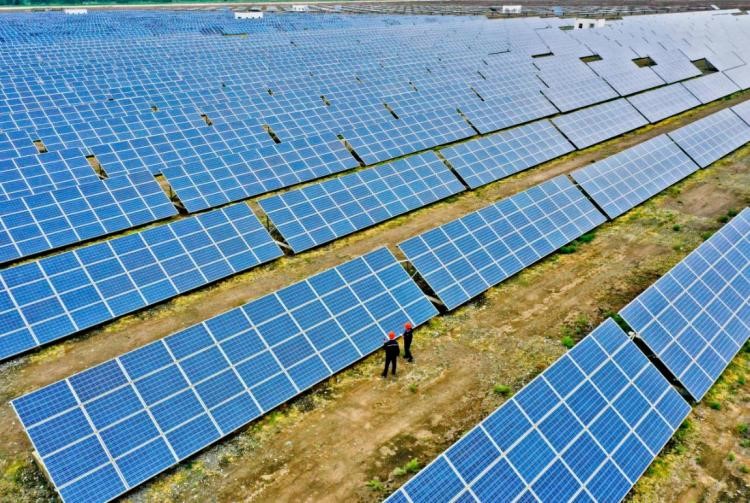Gross turnover of China’s national carbon market close to 300 mln yuan in first half month

Photo taken on June 25, 2021 shows an employee of a biomass power generation company based in Zhangye, northwest China’s Gansu province, operating grab bucket crane to move waste into receiving hopper. This year, Gansu province has kicked off the construction of 15 clean energy and production projects, including a clean energy industrial park in Zhangye. A total of 400 million yuan has been invested in these projects, which are expected to help realize China’s goal of peaking carbon dioxide emissions by 2030 and achieving carbon neutrality by 2060. (Photo by Wang Jiang/People’s Daily Online)
China’s national carbon emission trading market, which commenced trading on July 16, saw its total trading volume reach nearly six million tons and total turnover approach 300 million yuan ($46.44 million) as of July 30.
The national carbon market officially started trading at 9:30 a.m. on July 16. After 10 minutes, the cumulative volume of transactions exceeded 20 million yuan. During the four-hour carbon emission trading on that day, a total of 4.1 million tons of transactions were completed, with the carbon price closing at 51.23 yuan per ton on the very first day, up 6.73 percent from the opening price of 48 yuan.
Since carbon emission trading was kicked off, the national market has witnessed active transactions, steadily rising transaction price, and stable operation.
In the first industrial cycle of the national carbon market, more than 2,000 key carbon dioxide emitters in the power generation industry are included in the first batch of trading, covering approximately 4.5 billion tons of carbon dioxide emissions per year.
Before the national carbon market was launched, relevant pilot projects had been carried out in a number of provinces around the country for 10 years, promoting green transformation of many enterprises.
“Back then, our company bought about 250,000 tons of carbon dioxide emission quotas at around 60 yuan a ton,” said Zhou Shuiliang, deputy general manager of Guangzhou Hengyun Enterprises Holdings Ltd., a key emitter of greenhouse gases based in Guangzhou, capital of south China’s Guangdong province, referring to the first time when his company tried carbon emission trading in 2014.

Photo taken on June 24, 2021 shows staff members of China Longyuan Power Group Corporation Limited checking photovoltaic power generating facilities at an industrial park in Ganzhou district, Zhangye, northwest China’s Gansu province. (Photo by Wang Jiang/People’s Daily Online)
Guangdong was one of the first batch of provinces in China that piloted carbon emission trading. As a major power generation enterprise in Guangdong, Guangzhou Hengyun Enterprises Holdings Ltd. was included in the province’s carbon emission management system in 2014, and bought carbon emissions quotas worth about 15 million yuan that year as its actual amount of carbon emissions surpassed its quota.
With the in-depth implementation of the pilot project, Guangzhou Hengyun Enterprises Holdings Ltd. has realized that reducing carbon emissions does not just bring pressure, but also economic benefits as a result of carbon asset management and the application of technologies related to carbon emission reduction.
The company therefore established a work group for energy conservation and carbon reduction, upgraded and retrofitted generator sets, and vigorously carried out low-carbon and clean energy projects including natural gas power generation projects.
A sequence of transformations and upgrades have enabled the company to realize the change from buying carbon emission quotas to profiting from selling carbon assets. Last year, the company gained more than 30 million yuan from selling its carbon assets.
Like Guangzhou Hengyun Enterprises Holdings Ltd., many other enterprises that have made efforts to control greenhouse gas emissions have benefited from carbon market.
“More and more companies have realized that only by taking the initiative to reduce carbon emissions can they get a leg up in the wave of green and low-carbon transformation,” said Meng Meng, general manager of China Emissions Exchange (Guangzhou), the largest local carbon market in China.

Photo taken on June 24, 2021 shows a wind farm of China Longyuan Power Group Corporation Limited in Ganzhou district, Zhangye, northwest China’s Gansu province. (Photo by Wang Jiang/People’s Daily Online)
Carbon market piloted in Guangdong has seen active transactions, and ranked first in the country in terms of the cumulative volume of carbon emission quota transactions, which had exceeded four billion yuan by June this year, according to Meng.
“More importantly, carbon markets have practically promoted and yielded good results in reducing carbon emissions. By implementing mechanisms for controlling the total amount of carbon emissions, assigning quotas for carbon emissions, and honoring agreements, Guangdong’s carbon markets have realized an overall reduction in carbon emissions in absolute terms,” Meng said.
In 2019, Guangdong reduced 11.4 percent of carbon emissions, or 43.74 million tons from a year ago, according to Meng, who pointed out that practice in both foreign countries and domestic pilot areas has proven that carbon market is a policy instrument that can realize the reduction of carbon emissions with the lowest cost and highest efficiency.
The product in carbon markets is the trading of GHG emission permits. Companies that have been included in carbon emissions cap and trade systems like Guangzhou Hengyun Enterprises Holdings Ltd. are assigned quotas for carbon emissions. They need to buy carbon emission quotas from carbon market when they emit more greenhouse gases than they are allowed to, and can sell surplus emission allowances on the market when they successfully bring their actual amount of carbon emissions below their quotas.
The weighted average price for carbon quotas over the past few years stood at about 40 yuan a ton, according to the pilot carbon trading programs in seven cities.
Although pilot areas have carried out helpful exploration, due to limited market sizes, transaction prices of carbon quotas that can truly reflect the social cost of carbon emissions have not been formed, said Mei Dewen, general manager of China Beijing Environment Exchange.
Finding reasonable and effective prices for carbon quotas is an important goal and task in the construction of the national carbon market, according to Mei.
“The carbon market can be more dynamic and carbon quotas more efficiently priced only when diversified financial institutions and products are introduced into the market,” noted Mei, who explained that diversified market players have different risk preferences, forecasts, and sources of information, which helps form a relatively fair price and an effective market-based pricing mechanism.
To facilitate the development of spot carbon market, China Securities Regulatory Commission (CSRC) has actively provided guidance for Guangzhou Futures Exchange on speeding up the construction of carbon futures market, said Gao Li, spokesperson with the CSRC.
The permits to emit carbon emissions already have some basic properties of futures, such as a high degree of standardization, and long-term demand caused by the time difference between the issuance and performance of carbon emission quotas, said an executive from Guangzhou Futures Exchange.
Spot market is the foundation of the development of the futures market, the executive said, adding that when the futures market related to carbon trading takes shape and grows to a certain size, it will promote the development of the carbon market in various aspects.
Photos
Related Stories
Copyright © 2021 People's Daily Online. All Rights Reserved.










